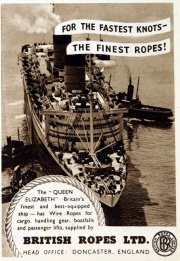British Ropes


of 52 High Holborn, London, WC2.
1924 British Ropes Ltd, incorporated on 6 June 1924, was formed through a merger of eight companies. Seven of these made wire rope only, whilst one (Craven and Speeding) made fibre products, particularly binder twine. The eight companies were[1]:
- Bullivant and Co London
- George Cradock and Co, Wakefield
- Craven and Speeding and Co, Sunderland
- D. H. and G. Haggie, Sunderland
- Haggie Brothers, Gateshead
- R. S. Newall and Son (Liverpool)
- Thomas and William Smith, Newcastle upon Tyne
- Tyne Wire Drawing Co, Gateshead, a subsidiary of Haggie Bros.
In 1925 and 1926 the new company acquired nine wire rope manufacturers, four firms of specialist wire drawers and five fibre rope makers. The wire rope companies were[2]:
- Allan, Whyte and Co, Rutherglen
- W. B. Brown (Bankhall), Liverpool
- Caledonian Wire Rope Co, Airdrie
- Dunn and King, Larbert
- Edwin Ellis and Co, Milwall and Stratford
- Excelsior Wire Rope Co, Cardiff
- Fred Scott of Atlas Wire Rope Works[3]
- John Stephens and Sons, Falmouth
- Warrington Wire Rope Co, Warrington and its interest in the Bristol Wire Rope Co.
The wire drawers were:
- Doncaster Wire Co
- Steel Wire Co
- Ordsall Wire Mills Ltd
- Parkinson and Bottomley Ltd[4]
- E. and A. Smith and Co
The fibre rope makers were:
- Charlton Ropeworks, Charlton
- J. T. Davies, Bow, London, a subsidiary of the wire rope manufacturers John Stephens and Co
- Edinburgh Roperie and Sailcloth Co,
- Frost Bros, London
- South Wales Rope Work Co, a subsidiary of Excelsior Wire Rope Co
1925 British Ropes also acquired a share of Templeborough Rolling Mills, giving the company an interest in a key materials supplier[5].
1926 Further investments had been made in a number of subsidiary companies including[6]:
- Ropeways Ltd
- Frederick W. Scott and Co Ltd
- Britannia Wire Rope Co. Ltd of British Columbia
1935 Built a new factory at Retford.
1936 Purchased John Homes of East Ardsley
1937 Wire, wirerope, hemprope, and sailcloth manufacturers. "Blue Strand" Tru-lay Aircraft Cord. [7]
Mid 1940s After rationalisation British Ropes operated only seven wire rope factories. These were located at: Cardiff, 2 plants at Doncaster, Gateshead, Retford, Rutherglen, and Wakefield. Fibre rope and cordage production had been concentrated at: Cardiff, Charlton, Leith, and Sunderland.
1948 Acquired Bristol Wire Rope Co and W. Cooke and Co (part purchased 1948, the remainder in 1954)
1953 British Ropes Ltd regained its original holding in Templeborough Rolling Mills, the first nationalised company to be sold by the Iron and Steel Holding and Rationalization Agency, which was their principal supplier of rod. British Ropes Ltd held 50 percent of the shares in William Cooke and Co Ltd[8].
1954 Acquired Humber Ropes, Grimsby and the remaining 50 percent of William Cooke
1959 Acquired R. Hood Haggie and Sons, Tyneside, with its subsidiaries Glaholm and Robson and Dixon Corbitt which had acquired R. S. Newall and Co.
1960 Ropes of steel wire, Sisal, Manila, Hemp, Nylon and of Terylene polyester fibre. [9]
1962 Acquired D. Morgan Rees, Cardiff and George Elliot and Co, Cardiff, with its eight subsidiaries including William Terrell and Sons
1963 Acquired Newburn Cordage, Newcastle upon Tyne, and Garnock, Bibby and Co, Liverpool, and Wrights Ropes, Birmingham, and its subsidiary Rollason Wire Co
1964 Sold B. and B. Trailers to Bullough Securities. [10]
1965 Acquired Great Grimsby Coal, Salt and Tanning Co (rope making interests only)
1966 Acquired Henry Bannister (purchase of goodwill only)
1967 Acquired Mitchell Ropeways and London Spinning Co, Deptford and Webster and Co, Sunderland
1968 Acquired Healey Brothers, Heywood
1968 Queen's Award to Industry for Technological Innovation. [11]
1969 Acquired Hugh Lewis and Sons
1970 Acquired Binks Brothers of Milwall,
1971 Acquired Gourock Ropework Co, Port Glasgow
1971 John Homes of East Ardsley and Healey Brothers of Heywood were amalgamated as British Twines Ltd
1973 British Steel sold its carbon- and mild-steel wire-making activities at Warrington (Rylands and Whitecross) and at Middlesbrough (Dorman Long) into a new company Rylands-Whitecross, jointly owned by Tinsley Wire Industries and British Ropes[12]
1974 the name of the parent company was changed to Bridon Ltd, with four subsidiary companies in the UK and Europe, comprising British Ropes, Bridon Wire, Bridon Fibres and Plastics and Bridon Engineering.
See Also
Sources of Information
- ↑ National Archives
- ↑ National Archives
- ↑ The Times November 20, 1925
- ↑ The Times November 20, 1925
- ↑ The Times Nov 20, 1925
- ↑ The Times, December 22, 1926
- ↑ 1937 The Aeroplane Directory of the Aviation and Allied Industries
- ↑ The Times, 5 August 1953
- ↑ Mining Year Book 1960. Published by Walter E. Skinner. Advert p3
- ↑ The Times, November 10, 1964
- ↑ The Engineer of 26th April 1968 p650
- ↑ The Times, Aug 17, 1973























